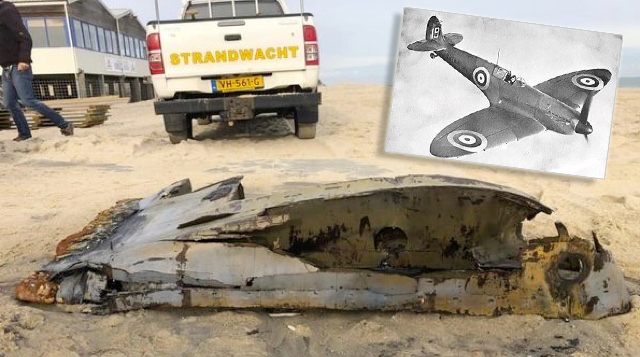You never know what can wash ashore….
Dutch media outlets are reporting an interesting discovery that took place at Vrouwenpolder, in the southwestern province of Zeeland, in the Netherlands, where a lifeguard found something special in the morning on Oct. 14, 2020. What appeared to be a large piece of debris, turned out to be a part of a Spitfire (or Seafire), one of the most famous fighter planes of WWII.
Many Spitfire aircraft taking part in the Battle of Britain were lost at sea and the piece that washed up some 75 years after the end of WWII may well belong to one of them. However, it’s worth remembering that, although the single-seat fighter aircraft was primarily operated by the Royal Air Force, other Allied countries flew the legendary British aircraft before, during, and after WWII. Actually, many Spitfire aircraft (including some replicas) are still flying today.
According to FAQT.nl, after finding the Spitfire, the lifeguards have contacted Central Zealand airport, where the wing is now going. The Wings to Victory foundation will try to trace the history of the aircraft and the pilot.
https://www.facebook.com/StichtingStrandexploitatieVeere/posts/1911413109001866?__xts__[0]=68.ARAWumXPz9F-IdcioygRCMz0_FQJsTa68ZpBXfjA8Ew8gCEF3KUXEJDn-z1O9tlJWhF1WnsQh4zmsLPDnKoTvvjJsj_6Y60nokmW9nTOJI7eQLt-AmUM7a3RR8NhI8u6uZMFrstAOCyjHc7qCcieQyGmnwme4-e7muPsGT7xZFIM9ys2Ty_InkheOIZhlbHrSp-l1161kg_FAdmtP3_0DCNOdAnJzHdtTsl3F-yP2BJmjAeKKohx3DUdoY1geRwG3Ar9Vz8sMONyn1s3L8iPsjkGOHciWf_gcGFTjHd46qcQgCFgkHfAKhDIBxUsOYcw2vYTuDUhl030LrQTBkpZTbJDQw&__tn__=-R
“When they called this morning with the message we found some fragments of a spitfire and they are made of wood, I thought: that cannot be right. Because almost everything on the spitfire is made of metal”, said Martien van Dijk of the Wings to Victory foundation. “But it turns out to be correct. Because it is an extra fuel tank and they were made of wood, especially at the end of the war.”
This is not the first time some aircraft part surface long after a plane crash. One of the most famous cases is the one of the Space Shuttle’s elevon that washed ashore on Cocoa Beach, Florida, on Dec. 17, 1996, almost 11 years after the loss of Challenger and its crew that occurred over Kennedy Space Center, shortly after launch of mission STS-51-L, on Jan. 28, 1986.
H/T @Gerjon_ for the heads up!













